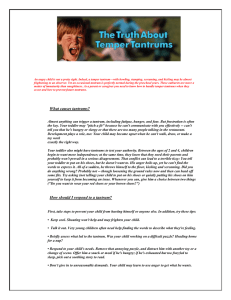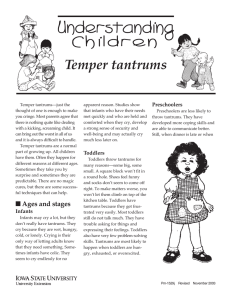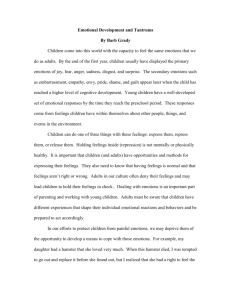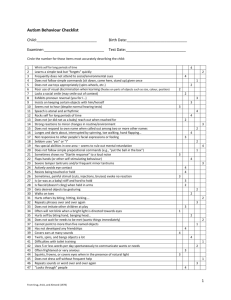/cfiv/downloads/1302.doc
advertisement
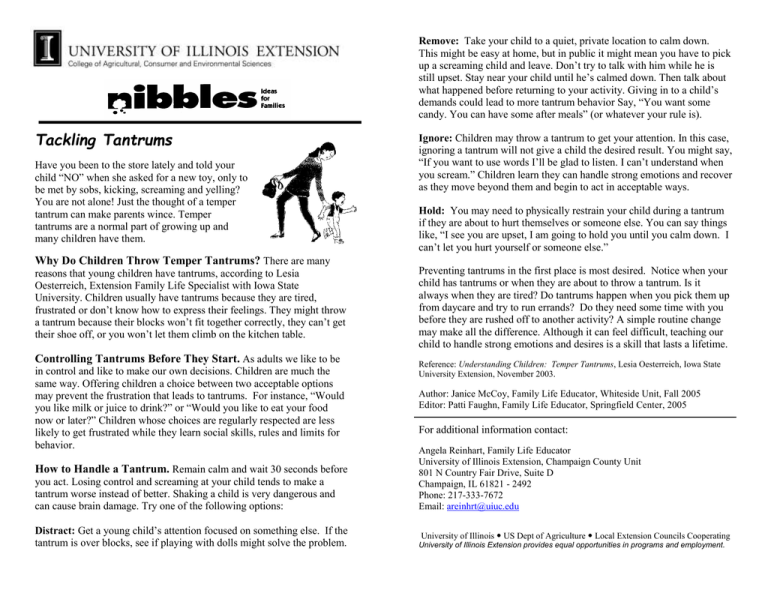
Remove: Take your child to a quiet, private location to calm down. This might be easy at home, but in public it might mean you have to pick up a screaming child and leave. Don’t try to talk with him while he is still upset. Stay near your child until he’s calmed down. Then talk about what happened before returning to your activity. Giving in to a child’s demands could lead to more tantrum behavior Say, “You want some candy. You can have some after meals” (or whatever your rule is). Tackling Tantrums Have you been to the store lately and told your child “NO” when she asked for a new toy, only to be met by sobs, kicking, screaming and yelling? You are not alone! Just the thought of a temper tantrum can make parents wince. Temper tantrums are a normal part of growing up and many children have them. Why Do Children Throw Temper Tantrums? There are many reasons that young children have tantrums, according to Lesia Oesterreich, Extension Family Life Specialist with Iowa State University. Children usually have tantrums because they are tired, frustrated or don’t know how to express their feelings. They might throw a tantrum because their blocks won’t fit together correctly, they can’t get their shoe off, or you won’t let them climb on the kitchen table. Controlling Tantrums Before They Start. As adults we like to be in control and like to make our own decisions. Children are much the same way. Offering children a choice between two acceptable options may prevent the frustration that leads to tantrums. For instance, “Would you like milk or juice to drink?” or “Would you like to eat your food now or later?” Children whose choices are regularly respected are less likely to get frustrated while they learn social skills, rules and limits for behavior. Ignore: Children may throw a tantrum to get your attention. In this case, ignoring a tantrum will not give a child the desired result. You might say, “If you want to use words I’ll be glad to listen. I can’t understand when you scream.” Children learn they can handle strong emotions and recover as they move beyond them and begin to act in acceptable ways. Hold: You may need to physically restrain your child during a tantrum if they are about to hurt themselves or someone else. You can say things like, “I see you are upset, I am going to hold you until you calm down. I can’t let you hurt yourself or someone else.” Preventing tantrums in the first place is most desired. Notice when your child has tantrums or when they are about to throw a tantrum. Is it always when they are tired? Do tantrums happen when you pick them up from daycare and try to run errands? Do they need some time with you before they are rushed off to another activity? A simple routine change may make all the difference. Although it can feel difficult, teaching our child to handle strong emotions and desires is a skill that lasts a lifetime. Reference: Understanding Children: Temper Tantrums, Lesia Oesterreich, Iowa State University Extension, November 2003. Author: Janice McCoy, Family Life Educator, Whiteside Unit, Fall 2005 Editor: Patti Faughn, Family Life Educator, Springfield Center, 2005 For additional information contact: you act. Losing control and screaming at your child tends to make a tantrum worse instead of better. Shaking a child is very dangerous and can cause brain damage. Try one of the following options: Angela Reinhart, Family Life Educator University of Illinois Extension, Champaign County Unit 801 N Country Fair Drive, Suite D Champaign, IL 61821 - 2492 Phone: 217-333-7672 Email: areinhrt@uiuc.edu Distract: Get a young child’s attention focused on something else. If the tantrum is over blocks, see if playing with dolls might solve the problem. University of Illinois Extension provides equal opportunities in programs and employment. How to Handle a Tantrum. Remain calm and wait 30 seconds before University of Illinois US Dept of Agriculture Local Extension Councils Cooperating
